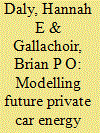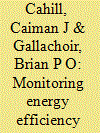|
|
|
Sort Order |
|
|
|
Items / Page
|
|
|
|
|
|
|
| Srl | Item |
| 1 |
ID:
115668


|
|
|
|
|
| Publication |
2012.
|
| Summary/Abstract |
Index decomposition analysis based on economic output is frequently employed to provide an indication of energy intensity trends in industry. Additionally, composite energy efficiency indicators, calculated using physical output, are used to give a more accurate view of energy efficiency progress. Both approaches are commonly presented in one study but often with a different mathematical basis for each. This may lead to inconsistent results. We demonstrate using practical case studies that when all physical and economic output data are available for industry sub-sectors, these can be combined in a single decomposition analysis that provides an energy efficiency indicator based on physical production and an indicator of the influence of structural change based on value added. Using the same methodology for both results ensures that the results are consistent and provides insights into the effects of changing prices of goods on aggregate energy intensity. In the case studies examined, falling unit values of industrial goods produced over time tend to increase the energy intensity of industry.
|
|
|
|
|
|
|
|
|
|
|
|
|
|
|
|
| 2 |
ID:
111397


|
|
|
|
|
| Publication |
2012.
|
| Summary/Abstract |
To-date, decomposition analysis has been widely used at the macro-economic level and for in-depth analyses of the industry and transport sectors; however, its application in the residential sector has been rare. This paper uses the Log-Mean Divisia Index I (LMDI-I) methodology to decompose gas consumption trends in the gas-connected residential sector in Ireland from 1990 to 2008, which despite an increasing number of energy efficiency policies, experienced total final consumption growth of 470%. The analysis decomposes this change in gas consumption into a number of effects, examining the impact over time of market factors such as a growing customer base, varying mix of dwelling types, changing share of vacant dwellings, changing size of new dwellings, the impact of building regulations policy and other factors such as the weather. The analysis finds the most significant effects are changing customer numbers and changing intensity; the analysis also quantifies the impact of building regulations and compares it with other effects such as changing size of new dwellings. By comparing the historical impact on gas consumption of policy factors and non-policy factors, this paper highlights the challenge for policy-makers in achieving overall energy consumption reduction.
|
|
|
|
|
|
|
|
|
|
|
|
|
|
|
|
| 3 |
ID:
116924


|
|
|
|
|
| Publication |
2012.
|
| Summary/Abstract |
In this paper we use a technological model of Ireland's future car stock to simulate the impact of a range of policy measures on the baseline trend in energy demand in the period to 2030. The policies and measures modelled comprise meeting deployment targets for electric vehicles and compressed natural gas vehicles, an EU regulation for the improvement of vehicle efficiency, implementation of a national biofuel obligation, as well as several behavioural measures (encouraging modal shifting and reduced travel demand). The impact of the different measures simulated is measured in terms of their contribution to meeting Ireland's ambitious targets for energy savings, for renewable energy penetration and for greenhouse gas (GHG) emissions reductions. The results point to a possible improvement of 32% in car stock efficiency, the achievement of 7.8% renewable energy share of road and rail transport and a 22% reduction in non-ETS private car CO2 emissions relative to 2009 levels. A scenario analysis on meeting the EV penetration target shows a significant range of CO2 emissions reductions depending on the cars (and mileage) displaced and on the electricity generation portfolio.
|
|
|
|
|
|
|
|
|
|
|
|
|
|
|
|
| 4 |
ID:
091524


|
|
|
|
|
| Publication |
2009.
|
| Summary/Abstract |
In 2006, energy-related CO2 emissions from transport energy in Ireland were 168% above 1990 levels. Private cars were responsible for approx 45% of transport energy demand in 2006 (excluding fuel tourism). The average annual growth of new cars between 1990 and 2006 was 5.2%. This paper focuses on these new cars entering the private car fleet, in particular the purchasing trend towards larger size cars. This has considerably offset the improvements in the technical efficiency of individual car models. The analysis was carried out on the detailed data of each individual new vehicle entering the fleet in 2000-2006. The average CO2 emissions per kilometre for new petrol cars entering the Irish fleet grew from 166 to 168 g CO2/km from 2000 to 2005 and reduced to 164 in 2006. For diesel cars the average reduced from 166 in 2000 to 161 in 2006. The paper also discusses how a recent change in vehicle registration taxation and annual motor tax had a significant impact purchasing trends by supporting lower emission vehicles. Cars with emissions up to 155 g CO2/km represented 41% of new private cars sold in Ireland in 2007 compared with 84% during the period July-November 2008.
|
|
|
|
|
|
|
|
|
|
|
|
|
|
|
|
| 5 |
ID:
121274


|
|
|
|
|
| Publication |
2013.
|
| Summary/Abstract |
One of the most notable outcomes of Ireland's recent spectacular rise in income was an apparent 140% increase in domestic passenger transport fuel use from 1990 to 2008, at the same time as the car stock has more than doubled in magnitude. However, there have been very few comparisons and decomposition analyses of the data underlying this increase in travel. This paper addresses this gap by (i) refining passenger transport data estimates, in particular improving existing estimates of passenger-kilometre data, (ii) comparing trends in Irish private car ownership, usage, and activity to international historical trajectories, and (iii) performing a decomposition analysis of Irish passenger transport using the Refined Laspeyres Method. The international comparison indicates that Ireland's per capita private car usage and car activity have followed intermediate trajectories relative to the historical paths of Sweden and the UK. These trajectories of car usage and activity have contributed to the growth in fuel use, and the Refined Laspeyres decomposition formally decomposes the factors accounting for this growth. Activity was the main driver of the increase in fuel use, although intensity also contributed significantly. Despite decreasing load factors and average annual distances in cars, activity has continued to rise each year.
|
|
|
|
|
|
|
|
|
|
|
|
|
|
|
|
| 6 |
ID:
110721


|
|
|
|
|
| Publication |
2011.
|
| Summary/Abstract |
Targeted measures influencing vehicle technology are increasingly a tool of energy policy makers within the EU as a means of meeting energy efficiency, renewable energy, climate change and energy security goals. This paper develops the modelling capacity for analysing and evaluating such legislation, with a focus on private car energy demand. We populate a baseline car stock and car activity model for Ireland to 2025 using historical car stock data. The model takes account of the lifetime survival profile of different car types, the trends in vehicle activity over the fleet and the fuel price and income elasticities of new car sales and total fleet activity. The impacts of many policy alternatives may only be simulated by such a bottom-up approach, which can aid policy development and evaluation. The level of detail achieved provides specific insights into the technological drivers of energy consumption, thus aiding planning for meeting climate targets. This paper focuses on the methodology and baseline scenario. Baseline results for Ireland forecast a decline in private car energy demand growth (0.2%, compared with 4% in the period 2000-2008), caused by the relative growth in fleet efficiency compared with activity.
|
|
|
|
|
|
|
|
|
|
|
|
|
|
|
|
| 7 |
ID:
099292


|
|
|
|
|
| Publication |
2010.
|
| Summary/Abstract |
Several index decomposition methods are commonly employed to provide a top-down view of energy consumption trends in manufacturing industry. These approaches typically use value added data for an industrial sector to decompose energy trends into structural, intensity and activity effects. Additionally in Europe a commonly employed top-down indicator called ODEX uses units of physical output, rather than value added, to analyse energy efficiency developments only. Therefore it has been difficult to compare ODEX directly to decomposition approaches. This paper presents a new decomposition method called VALDEX, based on the existing ODEX methodology, but using value added data. Extending ODEX to a full decomposition method allows tests commonly used in index decomposition theory to be applied and enables direct comparison with other methods. This helps evaluate the robustness of the existing ODEX methodology. Using industry data from three European countries, the results yielded by five decomposition methods are compared. In the cases examined, both the Laspeyres and VALDEX methods have significant residuals. Laspeyres consistently overestimates total energy consumption while VALDEX underestimates it. Methods that produce small or no unexplained residuals give converging results for each effect for the countries analysed, and provide a more reliable view of energy trends.
|
|
|
|
|
|
|
|
|
|
|
|
|
|
|
|
|
|
|
|
|